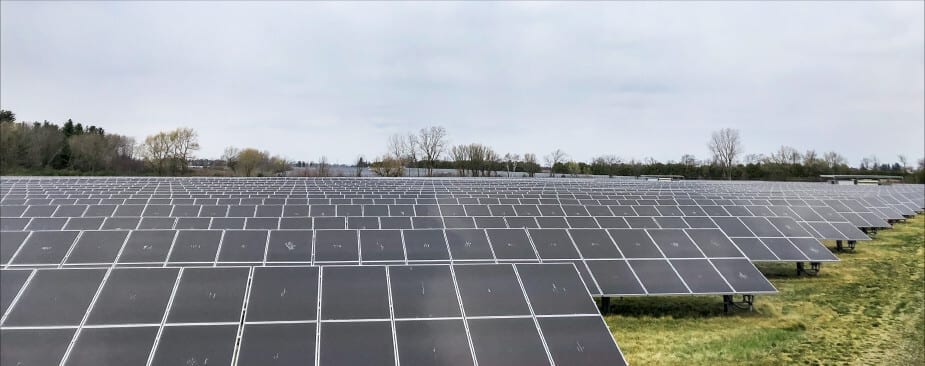
Here’s why Canada’s investment in clean energy is big news
April 30, 2021 Clean Energy
At the end of 2020, the Canadian government announced a strengthened climate plan, “A Healthy Environment And A Healthy Economy,” accompanied by a $15 billion initial investment. The ultimate goals of the plan? To help the country reach its 2030 emission reduction target as per the 2015 Paris Agreement, and to ultimately reach net-zero status by 2050.
As of February 2021, the government has also appointed 14 experts to its first Net-Zero Advisory Body, a team with the purpose of advising on the best pathways for Canada to achieve its net-zero 2050 objective.
It’s promising to see Canada picking up the pace and moving in the right direction to meet its climate change targets. The plan was a much-needed answer to Climate Action Network Canada’s 2019 “Getting Real About Canada’s Climate Plan” report that disappointingly found Canada among the worst of the G7 countries in terms of effective policy to reduce global rise in temperature, a direct result of global warming. While the Paris Agreement stated a goal of staying as close as possible to a rise in temperature of only 1.5 degrees Celsius (compared to pre-industrial levels), the report warned that Canada, along with all other parties to the Paris Agreement, did not have sufficient measures in place to limit warming to 1.5 degrees Celsius; rather, these nations would see warming of between 2.6 and 4 degrees Celsius if they continued down their current path. If Canada and other G7 countries fail to meet their climate change goals, continued temperature rises could result in a host of negative consequences. According to LiveScience.com, these consequences may include extreme weather events, polar ice melt and ocean acidification, and animal and plant species extinction.

Action items in the Canadian government’s 2020 strengthened climate plan include incentives for home, municipal, and commercial building retrofits, creating long-term jobs in Canada’s cleantech sector, and accelerating waste and pollution reduction.
Possible pathways to Net-Zero 2050
To bolster the strengthened climate plan and its initial $15 billion investment, the government’s 2021 budget includes an additional $17.6 billion investment in projects to further reduce greenhouse gas emissions; among these projects is the further creation and adoption of clean energy infrastructure.
Clean energy infrastructure could refer to any asset that produces clean energy, or assists/optimizes the production and delivery of it. This includes Electric Vehicles (EVs), solar assets, battery energy storage systems (BESS), and biogas facilities, to name a few. Elements of the budget include a plan to invest $964 million over four years to advance grid modernization projects, and investment in new cleantech jobs, which carries the promise of building Canadian cleantech expertise that allows us to improve the efficiency of our power grids.1
The Canadian Institute for Climate Choices’ summary report “Canada’s Net Zero Future: Finding Our Way In The Global Transition” (published independently to the government’s plan, but nonetheless a complementary offering), breaks down the four critical areas in which the country will be investing: buildings, transportation, industry, and negative emissions solutions. Within each of these areas is a mix of “safe bet” infrastructure that is already commercial available, such as EVs, solar energy, energy storage and biogas facilities converting waste to energy (such as power and renewable natural gas), and “wild card” infrastructure that is still being developed or perfected, such as carbon capture plants.
Canada is starting to see the adoption of many types of infrastructure, notably the “safe bets” such as EVs. From May 2019 to October 2020, over 65,000 Canadians and Canadian businesses have benefited from Canada’s Incentives for Zero-Emission Vehicles program. Adoption of EVs through this program is expected to reduce Canada’s greenhouses gas emissions by 2.7 million tonnes over the lifetime of those vehicles.2 Not only is the environmental benefit real, but end users will see cost savings. According to Clean Energy Canada, a Canadian EV driver will save between $800-$2000 annually in fuel costs, depending which provincial grid they plug into.
Canada is also starting to recognize the huge potential of biogas facilities; currently, there are about 200 active projects in Canada, and the government has pledged to invest $1.5 billion in a Low-carbon and Zero-emissions Fuels Fund to increase the production of low-carbon fuels, which includes Renewable Natural Gas (RNG).3

With differing mixes of “safe bets” and “wild cards” across the four sectors, the report identifies up to 62 possible pathways through which Canada can reach Net-Zero by 2050.4
By funding large clean energy infrastructure projects that offer companies enticing incentives to build, Canada will put more of these assets on the map. This is how Canada can ultimately build an interconnected network of clean energy production and consumption across the country.
Potential benefits for sustainable investments
Environmental, Social, Governance (ESG) funds are already seeing massive growth in popularity; in February 2021, Morningstar reported that Canadian ESG investing saw a 67% increase from 2019 to 2020, with 41 new sustainable funds available on the Canadian markets (twice the number launched in 2018). With more government investment in clean energy, there is naturally more opportunity for ESG funds and other types of sustainable investments to accelerate their growth, and thus potentially become even more of an attractive investment opportunity on both an individual and institutional scale.
Federal funds dispersed among multiple types of clean energy sectors will open up markets in ways that may not have been previously available to sustainable investment funds. As one example, potential new tax incentives on installing solar on commercial rooftops could result in benefits for the asset owner, the property owner, and even the tenant in terms of utility savings. A similar incentive has already been announced for homeowners and property owners: in April 2021 the Canadian government announced the launch of its plan to allow Canadians access to up to $40,000 in interest free loans to perform retrofits for energy-efficiency and resiliency to extreme weather as a result of climate change.
What the plan means for the everyday person
This investment flows through to benefit individuals in a significant way as well. Homeowners will find potential government incentives and utility savings by installing rooftop solar. With more funding for EVs and charging stations, it becomes easier for the everyday person to imagine themselves buying and driving an EV (not to mention accelerated technology and availability driving its affordability). As the ease and convenience of driving an EV becomes closer to that of a regular gas-powered vehicle, mass adoption of the technology becomes more likely.

The same can be said of sustainable living spaces, workplaces, and shopping places—with more available to choose from, and at greater affordability, it will be easier for individuals to make more sustainable choices in where they live, work, and shop. Studies have shown that many people do take sustainability into account when it comes to their lifestyle choices. For example, the 2019 Canadian Consumer Insights Survey reports that 33% of Canadian respondents said they’re willing to pay a premium for non-food items that are either sustainabily or ethically produced. Additionally, according to Fast Company, in a 2019 survey of 1,000 employees at large U.S. companies, over 70% said they were more likely to choose to work at a company with a strong environmental agenda.
Joining our global peers
Canada’s strengthened climate change plan signifies that we have recognized our situation is dire, and that significant action needs to be taken now to address our contribution to global warming.
It also sends a message to our global peers that we are joining them as we all push toward the same direction. The Canadian government’s 2020 “Restart, Recover and Reimagine Prosperity For All Canadians” report cites “Being the environmental, social, and governance (ESG) world leader in resources, clean energy, and clean technology” as one of four key pillars of a new industrial strategy to help Canadians prosper in the new post-COVID-19 world. 5 Canada is in good company, with the US government recently announcing its own investment (up to $4 trillion) in infrastructure with a heavy focus on tackling global warming via clean energy projects.
With the launch of its strengthened climate change plan, the Canadian government has made great strides. It is now up to Canadian industry to follow suit and adopt sustainable practices that keep us on track to meet our 2030 and 2050 emission reduction targets.

Tyler Balding
Director, Business Development, Skyline Energy
With 14 years of experience in the renewable energy sector and specialization in solar and battery technologies, Tyler aims to secure new clean energy solutions opportunities for the Skyline Energy team.
Skyline Energy manages clean energy assets for Skyline Clean Energy Fund, a sustainable investment offered as a private alternative investment product by Skyline Wealth Management.
1 A healthy environment and a healthy economy. (2021, April 8). Government of Canada. Retrieved April 27, 2021, from https://www.canada.ca/en/services/environment/weather/climatechange/climate-plan/climate-plan-overview/healthy-environment-healthy-economy.html
2 A healthy environment and a healthy economy. (2021, April 8). Government of Canada. Retrieved April 27, 2021, from https://www.canada.ca/en/services/environment/weather/climatechange/climate-plan/climate-plan-overview/healthy-environment-healthy-economy.html
3 A healthy environment and a healthy economy. (2021, April 8). Government of Canada. Retrieved April 27, 2021, from https://www.canada.ca/en/services/environment/weather/climatechange/climate-plan/climate-plan-overview/healthy-environment-healthy-economy.html
4 Canada’s Net Zero Future: Finding our way in the global transition (Summary Report). Canadian Institute for Climate Choices. Retrieved April 27, 2021, from https://climatechoices.ca/reports/canadas-net-zero-future/
5 Restart, recover and reimagine prosperity for all Canadians. (2020). Industry Strategy Council, Government of Canada. Retrieved April 29, 2021, from https://www.ic.gc.ca/eic/site/062.nsf/eng/00118.html.
About Skyline Clean Energy Fund
Skyline Clean Energy Fund (“SCEF”) is a privately owned and managed portfolio of medium to large scale clean energy assets, focused on acquiring income-producing assets across Canada, under long-term government contracts.
SCEF is offered as an alternative investment product through Skyline Wealth Management Inc. (“Skyline Wealth Management”), the exclusive Exempt Market Dealer (EMD) for SCEF.
SCEF is committed to surfacing value to its investors through asset monitoring and optimization, while providing a sustainable investment product based in clean, renewable energy.
To learn more about SCEF and its asset manager, Skyline Energy, please visit SkylineEnergy.ca.
To learn about additional alternative investment products offered through Skyline Wealth Management, please visit SkylineWealth.ca.
Skyline Clean Energy Fund is operated and managed by Skyline Group of Companies.
For media inquiries, please contact:
Cindy BeverlyVice President, Marketing & Communications
Skyline Group of Companies
5 Douglas Street, Suite 301
Guelph, Ontario N1H 2S8
cbeverly@skylinegrp.ca
More from this category:
Looking out on the climate and energy landscape: A review of 2021
The 2021 United Nations Climate Change Conference (COP26), held in Glasgow, Scotland this past fall, was another “last chance” to take decisive action on climate change. Though many feel global climate change efforts thus far haven’t quite made the grade, the parties did maintain, and even improved on, commitments to achieving the goals of the [...]
SCEF Purchases A Solar Project In Alberta
[Guelph, Ontario – October 31, 2022] On October 31, 2022, Skyline Clean Energy Fund acquired a ground-mounted solar development project through the purchase of 100% of the shares in 2289994 Alberta Inc. The project will be located at 202082 Range Road 174 Newell County, southeast of the Town of Bassano, Alberta. Once complete, the asset [...]
Canadian Clean Energy Fund Looks Back on Record Year; Anticipates Growing Energy Demand in 2023
[Guelph, Ontario – January 13, 2023] Skyline Clean Energy Fund (SCEF), a Guelph, Ontario-based equity growth fund investing in clean energy assets, is reporting several landmark achievements in 2022 and is looking to capitalize on further growth opportunities in the new year. In 2022, SCEF closed six transactions, increasing its Expected Annual Generation to 125,327 […]

